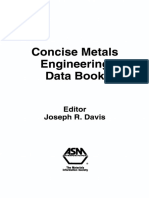0 ratings0% found this document useful (0 votes)
125 viewsCations
Cations
Uploaded by
pazucenaThe document lists common cations and anions in chemistry. Cations are positively charged ions and include metals like sodium, calcium, and copper. Anions are negatively charged ions such as chloride, sulfate, phosphate, and hydroxide. Together, cations and anions combine to form ionic compounds through the transfer of electrons from metals to nonmetals.
Copyright:
Attribution Non-Commercial (BY-NC)
Available Formats
Download as DOC, PDF, TXT or read online from Scribd
Cations
Cations
Uploaded by
pazucena0 ratings0% found this document useful (0 votes)
125 views2 pagesThe document lists common cations and anions in chemistry. Cations are positively charged ions and include metals like sodium, calcium, and copper. Anions are negatively charged ions such as chloride, sulfate, phosphate, and hydroxide. Together, cations and anions combine to form ionic compounds through the transfer of electrons from metals to nonmetals.
Copyright
© Attribution Non-Commercial (BY-NC)
Available Formats
DOC, PDF, TXT or read online from Scribd
Share this document
Did you find this document useful?
Is this content inappropriate?
The document lists common cations and anions in chemistry. Cations are positively charged ions and include metals like sodium, calcium, and copper. Anions are negatively charged ions such as chloride, sulfate, phosphate, and hydroxide. Together, cations and anions combine to form ionic compounds through the transfer of electrons from metals to nonmetals.
Copyright:
Attribution Non-Commercial (BY-NC)
Available Formats
Download as DOC, PDF, TXT or read online from Scribd
Download as doc, pdf, or txt
0 ratings0% found this document useful (0 votes)
125 views2 pagesCations
Cations
Uploaded by
pazucenaThe document lists common cations and anions in chemistry. Cations are positively charged ions and include metals like sodium, calcium, and copper. Anions are negatively charged ions such as chloride, sulfate, phosphate, and hydroxide. Together, cations and anions combine to form ionic compounds through the transfer of electrons from metals to nonmetals.
Copyright:
Attribution Non-Commercial (BY-NC)
Available Formats
Download as DOC, PDF, TXT or read online from Scribd
Download as doc, pdf, or txt
You are on page 1of 2
CATIONS ANIONS
NAME SYMBOL NAME SYMBOL
NH4+
Ammonium Acetate C2H3O2-
Au+
Aurous/Gold(l) Azide N3-
Cs+
Cesium Bromide Br-
Cu+
Cuprous/Copper(I) Bromate BrO3-
Fr+
Francium Chlorate ClO3-
H+
Hydrogen Chloride Cl-
Li+
Lithium Chlorite ClO2-
Hg 2
2+
Mercurous/Mercury(I) Cyanide CN-
K+
Potassium Dihydrogen phosphate H2PO4-
Rb +
Rubidium Fluoride F-
Ag +
Silver Hydride H-
Na+
Sodium Hydrogen carbonate HCO3-
(bicarbonate)
Ba2+
Barium Hydrogen sulfate (bisulfate) HSO4-
Be2+
Beryllium Hydrogen sulfite (bisulfite) HSO3-
Cd2+
Cadmium Hydroxide OH-
Ca2+
Calcium Hypochlorite ClO-
Cr2+
Chromous/Chromium(II) Nitrate NO3-
Co2+
Cobaltous/Cobalt(II) Nitrite NO2-
Cu2+
Cupric/ Copper (II) Iodate IO3-
Fe2+
Ferrous/Iron (II) Iodide I-
Mg2+
Magnesium Perchlorate ClO4-
Mn2+
Manganous/Manganese(II) Permanganate MnO4-
Hg2+
Mercuric/Mercury (II) Thiocyanate CNS-
Ni 2+
Nickel(II) Carbonate CO32-
Pb 2+
Plumbous/Lead(II) Chromate CrO42-
Sn 2+
Stannous/Tin(II) Dichromate Cr2O72-
Zn 2+
Zinc Hydrogen phosphate HPO42-
Al 3+
Aluminum Oxalate C2O42-
Sb 3+
Antimonous/Antimony (III) Oxide O2-
As3+
Arsemous/Arsenic (III) Peroxide O22-
Au 3+
Auric/Gold(III) Selenide Se2-
B 3+
Boron Stannate SnO32-
Cr 3+
Chromic/Chromium( III) Sulfate SO42-
Fe 3+
Ferric/Iron(III) Sui tide S2-
Ga 3+
Gallium Sulfite SO32-
Mn4+
Manganic/Manganese (IV) Tartrate C4H4O62-
Pb4+
Plumbic/Lead (IV) Telluride Te2-
Si4+
Silicon (IV) Thiosulfate S2O32-
You might also like
- Naming Compounds Cheat SheetDocument2 pagesNaming Compounds Cheat SheetYSA BELLENo ratings yet
- Electrovalency Table PDFDocument2 pagesElectrovalency Table PDFPriscaNo ratings yet
- Common Oxidation Numbers ChartDocument1 pageCommon Oxidation Numbers Chartsciencewoman100% (3)
- Harrison SLEDocument11 pagesHarrison SLEpazucenaNo ratings yet
- Social Psychology PSYC250Document21 pagesSocial Psychology PSYC250pazucenaNo ratings yet
- Alufinishing TrainingDocument36 pagesAlufinishing Trainingantzz alljc100% (1)
- Valence SheetDocument1 pageValence SheetQueenie BelleNo ratings yet
- Common Ion ChargesDocument1 pageCommon Ion ChargesMoganan SubramaniamNo ratings yet
- List of Common IonsDocument3 pagesList of Common Ionsangelonico100% (1)
- List of Cations and AnionsDocument1 pageList of Cations and AnionsEdaño, Camille T.No ratings yet
- Monoatomic and Polyatomic IonsDocument1 pageMonoatomic and Polyatomic IonsErika Rome PatocNo ratings yet
- Ions Tables 1+ 2+ 3+: Lithium Sodium Potassium Rubidium Caesium Silver Hydrogen Copper (I)Document1 pageIons Tables 1+ 2+ 3+: Lithium Sodium Potassium Rubidium Caesium Silver Hydrogen Copper (I)cNo ratings yet
- Grade 9 Valency ChartDocument3 pagesGrade 9 Valency Chartdiamehta1410No ratings yet
- Tabel IonDocument1 pageTabel IonAbu KamiliaNo ratings yet
- Ion Chart ExtractedDocument1 pageIon Chart Extractederror.sutNo ratings yet
- Ag Al Ba Be Ca CD Co CR, CR, CR Cs Cu, Cu, Cu Fe, Fe Ga H As As BR CL F H IDocument1 pageAg Al Ba Be Ca CD Co CR, CR, CR Cs Cu, Cu, Cu Fe, Fe Ga H As As BR CL F H IjonNo ratings yet
- ionicChargesChart PDFDocument1 pageionicChargesChart PDFronit675No ratings yet
- Ammonium, NH Copper (I), Cu+ Hydrogen, H Hydronium, H O Copper (II), Cu Aluminum, AlDocument3 pagesAmmonium, NH Copper (I), Cu+ Hydrogen, H Hydronium, H O Copper (II), Cu Aluminum, AlAditya RathiNo ratings yet
- Cations - Anions AlphabeticalDocument1 pageCations - Anions AlphabeticalNP100% (3)
- Series Toolkit Unit 5 Ionic Charges Chart Cations and AnionsDocument1 pageSeries Toolkit Unit 5 Ionic Charges Chart Cations and AnionsokNo ratings yet
- Common IonsDocument1 pageCommon Ionsapi-239855791No ratings yet
- Chem 1 List of IonsDocument2 pagesChem 1 List of IonsJean Angelove SantosNo ratings yet
- Common IonsDocument3 pagesCommon IonsabdallaaNo ratings yet
- Notes IonsDocument1 pageNotes IonsVeda Faine TaburaNo ratings yet
- List of RadicalsDocument2 pagesList of Radicalsmini2k4No ratings yet
- Symbol and Charges For Monoatomic and Polyatomic Ions, Oxidation Number, and Acid NamesDocument3 pagesSymbol and Charges For Monoatomic and Polyatomic Ions, Oxidation Number, and Acid NamesKelvin Mark KaabayNo ratings yet
- Cations: Ions and Charges Cations With Multiple ChargesDocument1 pageCations: Ions and Charges Cations With Multiple ChargesJohn Rey BayoguingNo ratings yet
- CationDocument2 pagesCationPuji RetnowatiNo ratings yet
- Basic Inorganic Nomenclature FOR IIT-JEE ENTRANCE TEST by S.K.sinha See Chemistry Animations atDocument5 pagesBasic Inorganic Nomenclature FOR IIT-JEE ENTRANCE TEST by S.K.sinha See Chemistry Animations atmyiitchemistry88% (17)
- List of Cation and AnionDocument2 pagesList of Cation and Anionnewtonenergy17No ratings yet
- List of IonsDocument1 pageList of IonsIsha Nathalie GalimbaNo ratings yet
- Names and Formulas of Common Ions: Positive Ions (Cations) Negative Ions (Anions)Document1 pageNames and Formulas of Common Ions: Positive Ions (Cations) Negative Ions (Anions)TusharNo ratings yet
- Cations and AnionsDocument5 pagesCations and Anionsrajeshwari143265No ratings yet
- Elements (Anions) Symbol Oxidation NO. Elements (Anions) Symbol Oxidation NODocument5 pagesElements (Anions) Symbol Oxidation NO. Elements (Anions) Symbol Oxidation NOJims Cudinyerah100% (1)
- Metals With More Than One IonDocument2 pagesMetals With More Than One IonPATRICIA JULIANNE CASTAÑETO RIVERA100% (1)
- Valency TableDocument1 pageValency TableRitesh SinghNo ratings yet
- Complex Ions: Al C N F Si P CL K Ba BR RB SR I Cu Ag Fe H PB ZNDocument2 pagesComplex Ions: Al C N F Si P CL K Ba BR RB SR I Cu Ag Fe H PB ZNelizabethNo ratings yet
- Chart of Common Ions/Ionic Charges: Positive Ions (Cations) Negative Ions (Anions)Document1 pageChart of Common Ions/Ionic Charges: Positive Ions (Cations) Negative Ions (Anions)renz_adameNo ratings yet
- CationsDocument2 pagesCationsOdd CatNo ratings yet
- Common Ions and Their ChargesDocument1 pageCommon Ions and Their ChargesNonbinaryBroadwayNo ratings yet
- Table of Common IonsDocument2 pagesTable of Common IonsReed ReedNo ratings yet
- Cations AnionsDocument2 pagesCations AnionsHannah Gwyneth SolanaNo ratings yet
- Ions - MemorizeDocument1 pageIons - MemorizeThea Clarice AmlonNo ratings yet
- Ion NamesDocument3 pagesIon NamesSatyamNo ratings yet
- Katyon Ve Anyon TablosuDocument1 pageKatyon Ve Anyon Tablosuhelen100% (1)
- Cation and AnionDocument2 pagesCation and AnionNBT OONo ratings yet
- List of Ions: I. CationsDocument4 pagesList of Ions: I. CationsJamille GamboaNo ratings yet
- Ions To MemoriseDocument2 pagesIons To MemoriseJOJO kidNo ratings yet
- Common Ions 18-19Document1 pageCommon Ions 18-19api-239855791No ratings yet
- Symbols and Charges For Monoatomic IonsDocument2 pagesSymbols and Charges For Monoatomic IonsaNo ratings yet
- Hydrogencarbonate Mercury (II) Hydrogen Sulfate Mercury (I) Hydrogen Sulfite OrthoborateDocument1 pageHydrogencarbonate Mercury (II) Hydrogen Sulfate Mercury (I) Hydrogen Sulfite OrthoborateVanessa RuizNo ratings yet
- Index Sa ChemistryDocument2 pagesIndex Sa ChemistryReiNo ratings yet
- Polyatomic Ions PDFDocument1 pagePolyatomic Ions PDFmaniz442No ratings yet
- Cations AnionsDocument1 pageCations AnionsTiviya Tarini ManiamNo ratings yet
- Common IonsDocument2 pagesCommon Ionsnickloo55No ratings yet
- Growing Up in Filipino FamiliesDocument2 pagesGrowing Up in Filipino FamiliespazucenaNo ratings yet
- Ajss Psychology Rev - Answer SheetDocument59 pagesAjss Psychology Rev - Answer SheetpazucenaNo ratings yet
- Organization of Muscle FiberDocument1 pageOrganization of Muscle FiberpazucenaNo ratings yet
- Growing Up in Filipino FamiliesDocument2 pagesGrowing Up in Filipino FamiliespazucenaNo ratings yet
- Kalusugan PangkalahatanDocument4 pagesKalusugan PangkalahatanpazucenaNo ratings yet
- Cook Time: 1 Hour, 10 Minutes Total Time: 1 Hour, 10 MinutesDocument2 pagesCook Time: 1 Hour, 10 Minutes Total Time: 1 Hour, 10 MinutespazucenaNo ratings yet
- OS 203 06262013 Integumentary SystemDocument5 pagesOS 203 06262013 Integumentary SystempazucenaNo ratings yet
- Story PyramidDocument1 pageStory PyramidpazucenaNo ratings yet
- KierkegaardDocument7 pagesKierkegaardpazucenaNo ratings yet
- History and P.E. of The Integumentary SystemDocument6 pagesHistory and P.E. of The Integumentary SystempazucenaNo ratings yet
- F Table of Ectodermal Derivatives: Fate Forerunner FunctionDocument2 pagesF Table of Ectodermal Derivatives: Fate Forerunner FunctionpazucenaNo ratings yet
- AristotleDocument8 pagesAristotlepazucenaNo ratings yet
- AvesDocument5 pagesAvespazucenaNo ratings yet
- Solipsism FINALDocument9 pagesSolipsism FINALpazucena100% (1)
- Health 4 NotesDocument60 pagesHealth 4 NotespazucenaNo ratings yet
- Cell TRansportDocument6 pagesCell TRansportpazucenaNo ratings yet
- Descriptive Model of Comstock Epithermal VeinsDocument15 pagesDescriptive Model of Comstock Epithermal VeinsmiguelNo ratings yet
- Astm E1806-23Document22 pagesAstm E1806-23zuqin bianNo ratings yet
- Corrosion of Metals and Their Protection: Learning GoalDocument36 pagesCorrosion of Metals and Their Protection: Learning GoalRyanNo ratings yet
- Lista Awwa 2019Document3 pagesLista Awwa 2019anderNo ratings yet
- Hypothetical Diagrams of Several Porphyry Copper DepositsDocument5 pagesHypothetical Diagrams of Several Porphyry Copper DepositsLidbert AlarcónNo ratings yet
- Ch1 - Chemical Equation NotesDocument7 pagesCh1 - Chemical Equation Notesਕੇਸ਼ਵ ਗੁਰਜਰNo ratings yet
- NDT Basic PresentationDocument207 pagesNDT Basic PresentationIvan AgurtoNo ratings yet
- Block Adventurer Geology Rocks Fact CardsDocument15 pagesBlock Adventurer Geology Rocks Fact Cardstamara pirilloNo ratings yet
- Investigatory Project On Metal CouplingDocument14 pagesInvestigatory Project On Metal CouplingAashishRanjan50% (2)
- Preparation CSWIP 2Document11 pagesPreparation CSWIP 2Mohd Farid OsmanNo ratings yet
- 6a895855 PodDocument5 pages6a895855 PodDiana MAANo ratings yet
- Upvc Door Chaukhat WindowsDocument1 pageUpvc Door Chaukhat WindowsA8304008005No ratings yet
- Request Form For MELISA Metal Allergy Testing: Instructions For Sample Taking Referred byDocument1 pageRequest Form For MELISA Metal Allergy Testing: Instructions For Sample Taking Referred byMárk KöllnerNo ratings yet
- Klasifikasi Material: Myrna Ariati Wahyuaji Narottama PutraDocument49 pagesKlasifikasi Material: Myrna Ariati Wahyuaji Narottama PutraAfril AltairNo ratings yet
- The Periodic Table of The ElementsDocument1 pageThe Periodic Table of The ElementsRohit RathodNo ratings yet
- The Impacts of Mining: A See, Judge, Act Reflection OnDocument64 pagesThe Impacts of Mining: A See, Judge, Act Reflection OnEvangeline GorospeNo ratings yet
- 19 Articulo - Mine Size and The Structure of CostsDocument22 pages19 Articulo - Mine Size and The Structure of CostsCristian Santivañez MillaNo ratings yet
- The New PEriodic Table SongDocument2 pagesThe New PEriodic Table Songpedro.sposito.uberaba.mgNo ratings yet
- Grinding of Tool SteelDocument20 pagesGrinding of Tool SteelJarek PlaszczycaNo ratings yet
- Diploma Workshop Practice IIDocument30 pagesDiploma Workshop Practice IISagir Musa SaniNo ratings yet
- Joe R. Davis, Joe R. Davis - Concise Metals Engineering Data Book-ASM International (1997)Document256 pagesJoe R. Davis, Joe R. Davis - Concise Metals Engineering Data Book-ASM International (1997)LuckyNo ratings yet
- Zintek® 300 HP + Techseal® Glossy Black SLDocument9 pagesZintek® 300 HP + Techseal® Glossy Black SLSyedMazharAliShahNo ratings yet
- Classifications of Dental Ceramics (Autosaved)Document52 pagesClassifications of Dental Ceramics (Autosaved)Muralidharan100% (1)
- Ebook Chemistry 10Th Edition Whitten Solutions Manual Full Chapter PDFDocument37 pagesEbook Chemistry 10Th Edition Whitten Solutions Manual Full Chapter PDFJaniceMarqueznxed100% (18)
- Special Steel StripDocument18 pagesSpecial Steel Striprakesh guptaNo ratings yet
- Theoretical and Applied Fracture MechanicsDocument13 pagesTheoretical and Applied Fracture MechanicsMario ChavezNo ratings yet
- Chemistry Project 2022-2023 Class 12th ADocument27 pagesChemistry Project 2022-2023 Class 12th ASAMAR TIWARINo ratings yet
- ALUMINUM - Chemistry PresentationDocument8 pagesALUMINUM - Chemistry PresentationAkshay BankayNo ratings yet
- MDSP-SET p4Document19 pagesMDSP-SET p4BrilliantJohnMalandacRubiaNo ratings yet


































































































